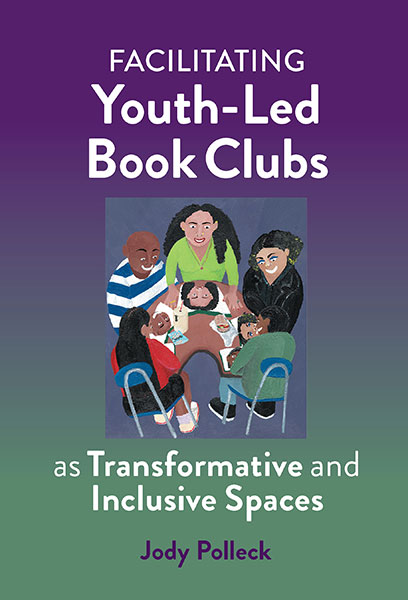Professors: Request an Exam Copy
Print copies available for US orders only. For orders outside the US, see our international distributors.
Publication Date: August 26, 2022
Pages: 176

Learn how to integrate book clubs into secondary school communities for transformation and inclusion so as to enhance and nurture students’ literacies along with their social and emotional development. Using her extensive experiences with culturally, neurologically, and linguistically diverse students, the author provides a rich resource that demonstrates how book clubs serve as critical places where adolescents can develop as readers while simultaneously working to build authentic relationships with their peers. Polleck offers research and theories grounded in culturally sustaining pedagogies and healing-centered engagements along with practical strategies for book club facilitators—from developing specific student-centered pedagogical approaches to embodying critical and humanizing dispositions.
Book Features:
Jody Polleck is an associate professor and the program coordinator for literacy education at Hunter College, City University of New York. She also continues to work in NYC schools as both a literacy coach and teacher.
“Facilitating Youth-Led Book Clubs as Transformative and Inclusive Spaces is full of gems to support teachers, librarians, literacy coaches, curriculum directors, school leadership, and teacher preparation programs with youth-led book clubs! I am inspired by the foundation that carries this work, specifically centered on youth experience, youth knowledge, and healing-centered approaches. The self-reflection questions and action plans in each chapter help all of us educators move beyond the work of curating book lists. I am thrilled to have a text that I can also use with colleagues to expand our text analysis, note taking, and theories that ground our book club work. Reading about equity audits, book club structures, and mini-lesson reading topics further emphasized that our facilitation exists within systems that must be assessed: those within and outside of our classrooms. Jody Polleck shows us how to bring together what we know about a text with what we learn from youth in ways that honor youth interests and positionalities. My planning and teaching have already improved thanks to the sample book club plans and youth voices across this book.”
—Carla España, assistant professor, Brooklyn College, City University of New York
Contents
Acknowledgments xi
1. Transformation and Inclusivity: The Foundation for Student-Centered Book Clubs 1
What Has Been My Journey to Book Clubs? 3
What Are Book Clubs? 5
What Does It Mean to Be Transformative and Inclusive? 7
Why Do We Need Book Clubs? 8
What Are the Benefits of Book Clubs? 9
Who Are Book Clubs For? 10
What Are the Theories That Ground Book Clubs? 12
What’s Coming Up? 15
2. Getting Book Clubs Started Within Our School Communities 18
Who Can Start and Facilitate Book Clubs? 19
What Is the Purpose of Your Book Clubs and Who Will Participate? 21
Where and When Do We Meet? 21
Which Books Do We Use and How Do We Get Them? 23
How Can We Be More Intentional About the Books We Read? 28
How Do We Get Students to Join Book Clubs? 30
How Do We Build Community to Prepare Students for Classroom-Based Book Clubs? 30
How Do We Build Literacy Skills to Prepare Students for Classroom-Based Book Clubs? 31
3. Creating Student-Centered, Inclusive Spaces Through Culturally Sustaining and Emotionally Responsive Facilitative Practices 36
What Does It Mean to Be a Culturally Sustaining and Emotionally Responsive Facilitator? 38
What Happens During Our First Book Club Session? 45
4. Maintaining, Sustaining, and Assessing Book Club Conversations 55
What Are the Structures We Can Use to Maintain Book Clubs? 57
What Are the Rituals We Can Use to Sustain Our Book Clubs? 66
What Mini-Lessons Can We Use to Sustain Our Book Clubs? 68
How Can We Nurture Students’ Reading Outside of Book Club? 72
What Assessments Can We Use to Maintain and Sustain Student Progress? 74
5. Developing Literacies and Spaces for Emotional and Identity-Based Engagements 81
What Do We Mean By Literacy Development? 82
What Does It Mean to Engage in Emotional and Identity-Based Work? 86
How Can We Address Trauma Within Our Book Clubs? 93
How Do We Simultaneously Address Reading Development Along With Emotional and Identity-Based Work? 94
How Do We Integrate Writing Into Book Clubs? 101
6. Developing Students’ Social Awareness, Interpersonal Relationships, and Agency 104
How Can We Use Book Clubs to Develop Students’ Social Literacies? 106
How Can Book Clubs Center Social Awareness? 112
How Can Book Clubs Help Students Develop Relationships? 114
How Can We Use Book Clubs to Impact Students’ Sense of Agency? 121
7. Engaging With Youth Families and in Digital Spaces 129
How Can Book Clubs Be Inclusive of Our Students’ Families? 129
What Do Book Clubs Look Like in Digital Spaces? 133
Epilogue: Centering Joy in Book Club Spaces 138
References 143
Index 156
About the Author 164
Professors: Request an Exam Copy
Print copies available for US orders only. For orders outside the US, see our international distributors.